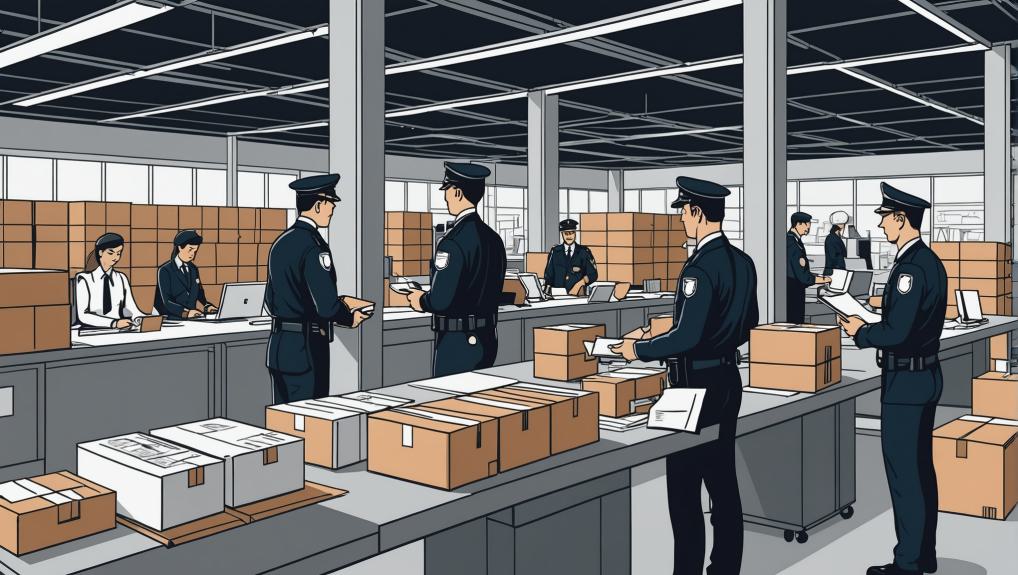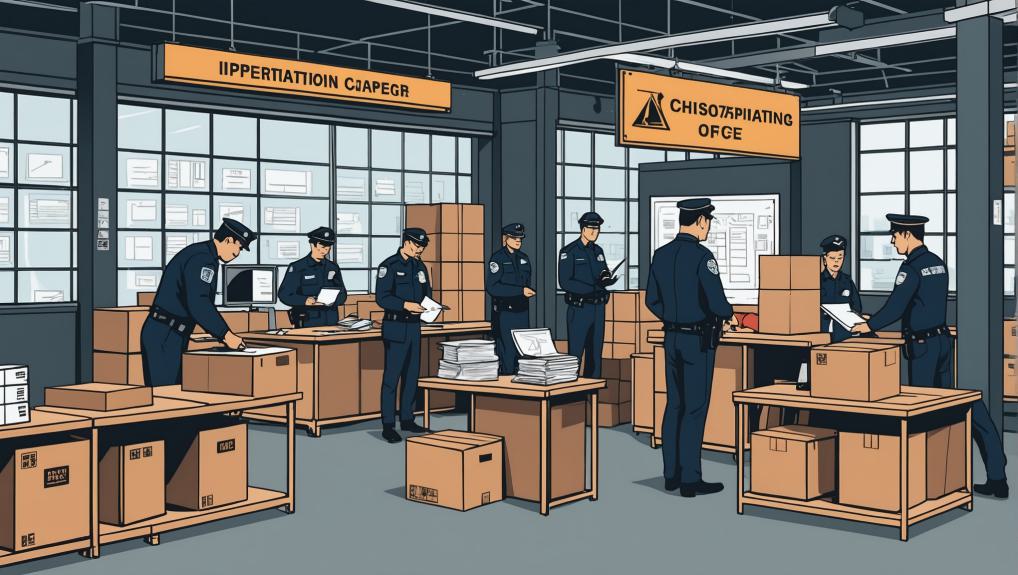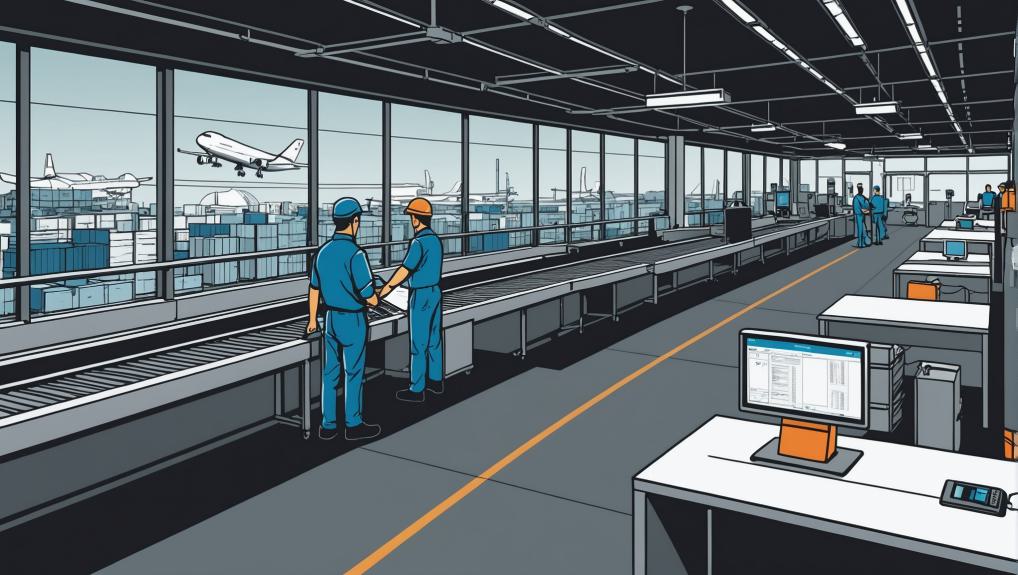When you see “Item Present to Import Customs” in your shipment tracking updates, it marks a crucial checkpoint in international shipping.
At this stage, customs authorities take over to inspect and clear your package. This phase can either smoothen the delivery process or lead to delays, depending on various factors.
Businesses often face significant pain points here. Delays can disrupt supply chains, while inaccurate documentation can lead to hefty fines or seizure of goods. Understanding this step is essential to mitigate such issues.
In this guide, we’ll break down what this status means, the potential pitfalls, and how to navigate them for seamless international transactions.
Key Takeaways:
- “Item Present to Import Customs” signifies the package is with customs for inspection and clearance, a critical step in shipping.
- Accurate documentation is essential to avoid delays, fines, or seizure during customs inspections.
- Delays can arise from high shipment volumes, incorrect documentation, or misclassified goods.
- Understanding customs processes helps ensure smooth international transactions and compliance with trade laws.
What does Item Present to Import Customs mean?

When a shipment is marked as ‘Item Presented to Import Customs,’ it means the package has been submitted to the destination country’s customs authorities for inspection and clearance.
This status indicates that the customs process has started, and the shipment will go through several key steps to ensure compliance with local laws and regulations.
First, customs officials inspect the package’s contents against the declaration provided by the sender. They check for prohibited or restricted items and confirm that the shipment meets the destination country’s import regulations.
Next, they review accompanying documentation, such as invoices, bills of lading, and certificates of origin, to ensure accuracy and completeness.
Customs authorities then assess any import duties and taxes based on the value, type, and origin of the goods. The payable amount depends on the destination country’s specific regulations.
Finally, a clearance decision is made. Customs will either clear the package for delivery or hold it for further action if there are issues like missing documentation, unpaid duties, or non-compliance with regulations.
This process is essential for regulating cross-border goods flow and ensuring adherence to legal requirements.
What reasons behind presenting import customs?
Presenting an item to import customs often happens due to incomplete or incorrect documentation, which requires further inspection and verification.
Delays and backlogs in customs operations can also necessitate additional scrutiny.
Accurately calculating and collecting taxes or customs duties are crucial reasons for review by import authorities.
Paperwork Problems
Accurate and complete documentation is crucial for smooth customs processing of imports. When an item reaches customs, paperwork problems can significantly delay its clearance. Common issues include incorrect or inconsistent documentation.
Errors such as incorrect product names, inconsistent descriptions, or incorrect currency declarations can cause major delays.
Customs officials need precise information to verify the nature and value of the goods; discrepancies can lead to further scrutiny.
Another frequent issue is missing licenses or permits. Certain items require specific import licenses or quality inspection registrations, and failing to provide these can result in substantial delays.
For example, some goods might need health certificates, safety compliance documents, or environmental permits depending on their nature and origin.
Without these critical documents, customs authorities may not allow the item to proceed, delaying its entry into the market.
To avoid these pitfalls, importers must meticulously prepare all necessary documents, ensuring their accuracy and completeness. This diligence not only facilitates smoother customs processing but also helps in avoiding penalties or additional inspections.
Delays & Backlog in Customs
Delays and backlogs in customs arise from multiple factors, even when meticulous documentation is provided.
A primary cause is the sheer volume of shipments that customs authorities must manage. High volumes can overwhelm the system, leading to substantial backlogs.
Inaccurate cargo classification also contributes significantly to delays. Misclassified goods require customs officials to spend additional time verifying the correct classification, which prolongs the inspection process.
This issue becomes more pronounced during peak shipping periods when the volume of shipments is already high.
Consignee-related issues further exacerbate delays. If the recipient of the goods is unprepared to handle customs formalities or delays in paying the required duties, the shipment will remain in customs longer than expected.
This not only affects the specific shipment but also adds to the overall backlog.
Empirical evidence supports these observations. For instance, during the holiday season, customs authorities often face a surge in shipments, leading to increased delays and backlogs.
Taxes or customs duties
Import customs duties ensure the accurate assessment and collection of taxes on imported goods.
Customs authorities evaluate items to determine the appropriate duties and taxes owed, considering factors such as value, weight, and type of goods. This process is crucial for several reasons.
Customs duties are calculated based on various criteria, including the declared value of the goods.
This can be complex, requiring meticulous review to prevent undervaluation or misclassification. For example, if an importer declares a lower value to reduce taxes, customs authorities must verify the actual value to ensure fairness.
Compliance with tariffs and duties is also essential. Some goods may be subject to specific tariffs or additional duties like anti-dumping or countervailing duties.
These measures protect local industries from unfair competition and maintain a level playing field. By assessing items at import customs, authorities can enforce these regulations effectively.
Ultimately, presenting items to import customs ensures that all applicable taxes and duties are collected, regulating the flow of goods and safeguarding economic interests.
What is the process of declaring “Item Present to Import Customs when importing goods?

Declaring ‘Item Present to Import Customs’ when importing goods is a structured process aimed at complying with customs regulations and ensuring accurate duty and tax assessments.
The process starts with preparing essential documents like the Bill of Entry, Commercial Invoice, Packing List, and possibly an Import License. These documents detail the goods, their value, and packaging.
Submit the customs declaration electronically or via physical documentation, specifying the goods and their intended use.
Customs authorities review and verify this documentation for accuracy and completeness. They classify and value the goods to determine the correct duties and taxes.
Customs may conduct a physical examination to ensure the contents match the declaration and check for prohibited items. Inspections can vary from random sampling to detailed examinations if discrepancies are detected.
After assessment, the importer must pay the calculated duties and taxes. Once payment is made, customs clears the goods, allowing the importer to take possession.
Post-clearance, the importer must follow any additional requirements, such as record-keeping and reporting to customs authorities.
This process ensures compliance with customs regulations and accurate duty and tax assessments, facilitating smooth importation.
Why is it important to accurately declare “Item Present to Import Customs” when importing goods?
Accurately declaring ‘Item Present to Import Customs’ when importing goods is crucial to ensure compliance with customs regulations and prevent legal and financial consequences.
Non-compliance can result in severe penalties, such as fines and seizure of goods.
For example, in the UK, significant irregularities can lead to penalties of up to £2,500 per contravention, while minor issues can incur fines up to £1,000 per contravention.
Correct declarations also help avoid delays and backlogs in the customs clearance process. Errors in documentation, such as incorrect tariff codes or missing information, can cause goods to be held for further inspection, disrupting supply chains and leading to additional storage costs.
Moreover, accurate declarations are necessary for proper duty and tax assessment. Customs duties and taxes are calculated based on the declared value, origin, and classification of goods.
Misdeclarations can result in financial issues, such as underpayment or overpayment of duties, and may lead customs authorities to reassess and impose additional duties retroactively.
How Does the “Item Presented to Import Customs” Update Work?

The ‘Item Presented to Import Customs’ update means the shipment has reached the customs authorities of the destination country and is undergoing clearance procedures.
First, the carrier electronically files an Import General Manifest (IGM), detailing all the goods on board. This document initiates the customs process.
Next, the importer or their customs broker submits a customs declaration. This includes essential documents like the Bill of Entry, commercial invoice, packing list, and any required licenses. Submitting these documents electronically speeds up the process.
Customs officials then assess and verify the documents for accuracy and completeness. They classify the goods, determine their value, and calculate applicable duties and taxes.
Depending on the goods and the provided information, customs may conduct a physical examination to ensure compliance with regulations.
After the assessment, customs authorities calculate the duties and taxes owed. The importer must pay these fees, usually electronically, before the goods can be released.
Once payment is made, customs issues a release order, allowing the goods to leave customs custody and proceed to their final destination.
This structured process ensures compliance with local laws and regulations, facilitating smooth and lawful importation.
How does declaring “Item Present to Import Customs” affect the customs clearance process?
Declaring an item as ‘Present to Import Customs’ kicks off a vital phase in the customs clearance process.
It sets the stage for document verification, duty assessment, and potential physical inspections, all of which impact the efficiency and accuracy of clearance.
Customs officials first verify documents like the bill of entry, commercial invoice, and packing list. This ensures all the information is correct. They then assess duties and taxes based on the declared value, classification, and origin of the goods.
Proper classification is crucial because it determines duty rates and trade restrictions. Accurate declarations help calculate the correct duties and taxes, avoiding financial discrepancies.
Customs may also perform physical examinations of the goods to verify the declaration’s accuracy and ensure compliance with import regulations.
These inspections can range from random checks to detailed reviews, depending on the nature of the goods and the information provided.
Accurate declarations prevent delays and penalties. Misdeclarations can lead to inspection delays, fines, or even the seizure of goods.
Precise declarations streamline the clearance process by ensuring regulatory compliance and supporting smooth international trade.
Post-clearance procedures, like record maintenance, also depend on accurate initial declarations.
What are the consequences of not declaring “Item Present to Import Customs” when importing goods?

Failing to declare ‘Item Present to Import Customs’ when bringing goods into a country can lead to grave financial, legal, and operational consequences. Importers risk hefty fines that vary depending on the value of the undeclared items.
In Canada, for instance, penalties can range from $500 to $1,000 for goods valued at $500, with repeat offenses leading to more severe repercussions like withdrawal of travel privileges or even criminal charges.
Customs authorities might seize undeclared goods, causing significant financial setbacks. Seized items are held until the required documentation and fines are settled, and in some cases, they may be forfeited permanently.
Extreme violations, such as smuggling prohibited items like drugs or weapons, can result in criminal charges, imprisonment, and a permanent criminal record.
Non-compliance can also result in denial of entry, disrupting personal and professional plans. Misdeclared goods might be confiscated and auctioned, and while importers can sometimes reclaim them by paying fines, this is not always guaranteed.
Legal and administrative penalties, including temporary detention of goods or funds and administrative fines, are also possible.
Frequently Asked Questions
How Long Does Customs Clearance Usually Take After Declaring ‘Item Present to Import Customs’?
Customs clearance usually takes anywhere from a few hours to several days after declaring ‘Item Present to Import Customs.’ The duration depends on factors like country-specific regulations and the completeness of the documentation.
Are There Fees Associated With Presenting Items to Import Customs?
Yes, fees are associated with presenting items to import customs. These fees can include duties, taxes, and handling charges. The exact costs depend on the country and the specific nature of the imported goods.
Can I Track My Package After It Has Been Presented to Import Customs?
Yes, you can track your package after it has been presented to import customs. Most shipping carriers, like FedEx, UPS, and DHL, provide updated tracking information that reflects your package’s current status and location during the customs clearance process.
What Should I Do if My Shipment Is Delayed at Import Customs?
If your shipment’s delayed at import customs, contact your shipping provider for updates. Ensure all required documentation is complete. Consider hiring a customs broker to expedite the process and ensure compliance with regulations.
Conclusion
‘Item Present to Import Customs’ refers to the declaration that an item has arrived and is ready for inspection by customs authorities. This step is crucial for ensuring a smooth customs clearance process.
Customs officials review and verify shipment documentation and contents to prevent delays, penalties, and potential seizures.
Following these procedures not only facilitates timely delivery but also ensures compliance with international shipping regulations. Understanding and adhering to this process is essential for the efficient and lawful importation of goods.
For instance, when a shipment reaches a port, the importer must declare its arrival to customs.
This involves submitting detailed documentation, including invoices, packing lists, and any required permits. Customs authorities then inspect the shipment to ensure it complies with all regulations and standards.
Failure to properly declare can lead to significant delays, fines, or even confiscation of the goods.
In essence, the declaration of ‘Item Present to Import Customs’ is a critical step in international trade. It helps maintain a streamlined import process, ensuring that goods reach their destination without unnecessary hindrance.

